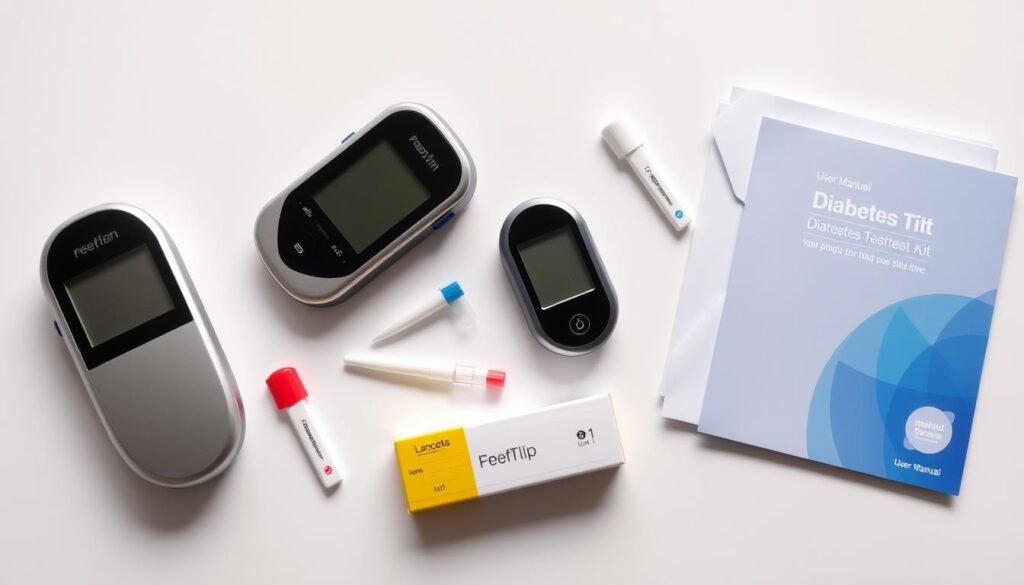Table of Contents
ToggleFor people with diabetes, keeping blood sugar levels healthy is key. A good diabetes test kit can really help with this. These kits let you check your blood glucose easily, helping you manage your diabetes better. With so many choices out there, picking the right one can feel overwhelming. This guide will walk you through the best features, benefits, and top picks to make your choice easier.
Key Takeaways
- Diabetes test kits provide a convenient and effective way to monitor blood glucose levels.
- Choosing the right test kit can be challenging, with various features and options to consider.
- Accurate and user-friendly design are crucial factors in selecting the best diabetes test kit.
- Compatibility with other diabetes management tools and integration with mobile apps can enhance the overall experience.
- Affordability and insurance coverage are also important considerations when choosing a diabetes test kit.
Understanding Blood Glucose Monitoring
Managing diabetes well needs accurate blood glucose checks. There are two main devices for this – continuous glucose monitors (CGMs) and blood glucose meters (BGMs). CGMs track glucose in the interstitial fluid all day. BGMs need a fingerstick for each reading.
Types of Blood Glucose Monitors
CGMs have a small sensor under the skin to track glucose in the interstitial fluid. This info goes to a receiver or a smartphone app. BGMs, on the other hand, measure glucose from a blood drop from a fingerstick.
Importance of Accurate Monitoring
Getting accurate glucose readings is key for managing diabetes well. It helps with insulin doses and treatment choices. But, many things can affect BGM accuracy, like blood type, the environment, and how the device is made. It’s important to pick a device that can handle these issues well for reliable glucose data.
| Metric | Continuous Glucose Monitors (CGMs) | Blood Glucose Meters (BGMs) |
|---|---|---|
| Measurement Site | Interstitial Fluid | Capillary Blood |
| Sampling Frequency | Continuous (every 5-15 minutes) | Intermittent (based on user) |
| Data Presentation | Glucose trends, patterns, and alerts | Single glucose values |
| Key Features | Glucose level tracking, trend analysis, alarms | Portability, simplicity, affordability |
Choosing between a CGM or BGM depends on your needs and lifestyle. Knowing the good and bad of each monitor helps you make a smart choice. This way, you can manage your diabetes better.
Also Read : Exploring The Career Path Of A Medical Lab Technologist
Key Factors to Consider When Choosing a Diabetes Test Kit

When picking a blood glucose meter, accuracy is key. Look for the latest technology for reliable results. A small blood sample size, like 0.5 microliters or less, makes testing easier.
Easy to use is crucial too. Pick a meter that’s simple and quick to use. The size and clarity of the meter and its display matter a lot. A “no code” meter that doesn’t need extra steps is very handy.
- Accuracy: Ensure the meter provides reliable and consistent results.
- Blood Sample Size: Look for a meter that requires a tiny blood sample, such as 0.5 microliters or less.
- Ease of Use: Choose a simple, intuitive meter that makes testing quick and easy.
- Meter and Display Design: Consider the size and visibility of the meter and display.
- No Coding: Opt for a pre-calibrated “no code” meter to eliminate an extra step.
- Data Capabilities: Determine your preferred method for tracking and reviewing glucose readings.
- Connectivity: Look for Bluetooth connectivity to seamlessly sync your data.
- Test Time: Select a meter with fast results, typically 5-6 seconds or less.
- Affordability: Consider both the one-time meter cost and ongoing test strip expenses.
- Alternate Site Sampling: If desired, choose a meter that allows testing from sites other than your fingertip.
Think about these factors to find the right diabetes test kit for you. It should be accurate, easy to use, and affordable for blood glucose monitoring.
“Accurate, convenient, and affordable blood glucose monitoring is essential for effectively managing diabetes.”
Also Read : Strategies For Loan Approval With Limited Credit History
Diabetes Test Kit: Features, Benefits, And Top Picks

Managing diabetes means keeping an eye on blood glucose levels. There are many diabetes test kits out there, each with its own set of features and benefits. Let’s look at the best continuous glucose monitors (CGMs) and blood glucose meters (BGMs) available.
Also Read : What Should You Look For In A Business Credit Card Offers?
Continuous Glucose Monitors (CGMs)
CGMs have changed how people with diabetes handle their condition. They track glucose levels in real-time, helping users make smart choices about their health. Top CGMs like the Dexcom G6, FreeStyle Libre, Nutrisense CGM, Signos CGM, and Levels Health CGM offer wireless connectivity and trend analysis. They also have customizable alerts to keep blood sugar in check.
Blood Glucose Meters (BGMs)
Blood glucose meters (BGMs) are still key for managing diabetes. They give quick and accurate readings, helping users adjust their treatment plans. The best BGMs include the Contour Next One, Eversense, Guardian Connect System, Rite Aid TrueMetrix Meter, and Walgreens TrueMetrix Bluetooth Blood Glucose Meter. These meters have Bluetooth connectivity and easy-to-use interfaces for better diabetes care.
Choosing between a CGM or a BGM depends on your needs and lifestyle. Knowing the features and benefits of each option helps you make a smart choice. This way, you can better manage your diabetes.
Also Read : How Does A Quick Loan Differ From A Traditional Personal Loan?
Choosing the Right Diabetes Test Kit for Your Needs

Choosing the right diabetes test kit is key to managing your diabetes. Think about your diabetes type, lifestyle, and needs. Also, consider your budget, testing frequency, and insurance coverage.
Also Read : How Can Real Estate Be Used As Loan Security?
For those with diabetes, continuous glucose monitors (CGMs) are great for real-time glucose tracking. They give you glucose data all day and night. But, they might be pricier than blood glucose meters (BGMs).
If you’re on a budget or need basic diabetes management, a blood glucose meter is a good choice. These devices are affordable and let you test your blood sugar easily. They also connect to apps and platforms for tracking and sharing data with your doctor.
It’s important to talk to your healthcare provider about what you need. They can help pick the best device and testing plan for you. They consider your diabetes type, lifestyle, budget, and insurance.
By looking at all these factors, you can find the diabetes test kit that fits your diabetes management and health goals.
“Effective diabetes management starts with choosing the right tools to monitor your blood sugar levels.”
Also Read : How Can I Choose The Right Medical Service Provider For My Needs?
Conclusion
Managing diabetes well means keeping an eye on your blood sugar levels. You can use a continuous glucose monitor (CGM) or a traditional blood glucose meter (BGM). It’s important to pick a diabetes test kit that fits your needs. Think about how accurate it is, how easy it is to use, what data it gives you, its cost, and how it fits into your diabetes care plan.
When looking at the different options, talk to your healthcare provider. They can help you choose a diabetes test kit that gives you the right glucose data. This way, you can manage your diabetes better and improve your health. With the right tool, you can control your diabetes and keep your blood sugar levels in check. This leads to a healthier and happier life.
Choosing the right diabetes test kit is key to managing your diabetes well. Look for one that is accurate, easy to use, and tailored to your needs. With the latest in diabetes technology, the future of managing blood sugar levels is exciting. It’s all about finding a solution that fits into your daily life and helps you reach your health goals.
FAQs
Q: What are diabetes test strips used for?
A: Diabetes test strips are used in conjunction with a glucose meter to measure blood sugar levels. They are an essential part of a blood sugar test kit, allowing individuals to monitor their blood glucose levels effectively.
Q: How do I use a glucose meter with test strips?
A: To use a glucose meter with test strips, first insert a test strip into the meter. Then, use a lancet to obtain a drop of blood from your fingertip. Apply the blood to the test strip, and the meter will display your blood sugar reading within seconds.
Q: What is the difference between type 1 and type 2 diabetes in terms of testing?
A: Both type 1 and type 2 diabetes require regular blood sugar testing to manage the condition. However, individuals with type 1 diabetes may need to test more frequently due to their reliance on insulin, whereas those with type 2 diabetes may have more flexibility in their testing schedules based on their treatment plan.
Q: How often should I test my blood sugar levels?
A: The frequency of testing your blood sugar levels depends on your diabetes management plan. It’s advisable to check your blood sugar at least once a day, but some individuals may need to test multiple times per day, especially if they are adjusting their diabetes treatment or experiencing high or low blood sugar levels.
Q: What should I do if my blood sugar reading is high?
A: If your blood sugar reading is high, it is essential to follow your diabetes care plan. This may involve taking prescribed medication, adjusting your diet, or engaging in physical activity. Always consult your healthcare provider for personalized advice on managing high blood sugar levels.
Q: Can I use expired diabetes test strips?
A: No, you should not use expired diabetes test strips, as they may not provide accurate blood glucose test results. Always check the expiration date on the packaging and store your test strips as directed to ensure their effectiveness.
Q: What are glucose test strips made of?
A: Glucose test strips are typically made of a thin plastic material that contains enzymes and chemicals which react with glucose in the blood. This reaction generates an electrical signal that the glucose meter measures to provide a blood glucose test result.
Q: What is a control solution and why is it important?
A: A control solution is a liquid with a known glucose concentration used to check the accuracy of the blood glucose testing system. Regularly using a control solution helps ensure that both the glucose meter and test strips are functioning correctly, providing reliable blood sugar test results.
Q: How do I store my blood sugar test kit and test strips?
A: Store your blood sugar test kit and test strips in a cool, dry place away from direct sunlight. Ensure that the cap is tightly closed on the test strip vial to maintain their effectiveness, and always refer to the manufacturer’s instructions for specific storage guidelines.
Q: What should I do if I experience pain while testing my blood?
A: If you experience pain while testing your blood, try using a different lancet or adjusting your technique. Ensure that you are using a proper blood draw site and technique. If the pain persists or increases, consult a healthcare professional for guidance.





